18-22 November 2009 |
Photos & text © Don Roberson |
|
||||
Grasswrens are endemic Australian members of family Maluridae, which includes fairywrens and emu-wrens. I have long been fascinated by the grasswrens of Australia, ever since the publication of Richard Schodde's (1982) monograph Fairy-Wrens. The book is full of wonderful stories of discovery, loss, re-discovery, and taxonomic challenges. At the time of its publication there were considered to be eight species of grasswren in genus Amytornis. Now there are generally considered to be ten species, with recent splits in Striated and Dusky Grasswrens. Schodde's tome is enlivened by full page art by Richard Weatherly, showing each species or subspecies in habitat. The combination of fine text and great art makes this book the best "bird family book" ever published, in my opinion. I had the good fortune to meet Weatherly at O'Reilly's in Lamington Nat'l Park in 1983, shortly after the book's publication, and got his autograph on my copy. I'd visited Australia four different times before 2009, and despite having a decent list of Australian birds, every single grasswren had previously eluded me. Rita and I searched for two species in August 2008 in the Northern Territories, but did not find them in a winter plagued by a prolonged drought. I joined this short tour in hopes of seeing (and photographing?) my first grasswrens. The tour was led by Peter Waanders, with Bruce Wedderburn, Murray Lord, and me as participants. |
||||
#1 STRIATED GRASSWREN Amytornis striatus |
||||
 |
||||
Portion of painting (right) by Richard Weatherly from Schodde (1982) |
#2 SHORT-TAILED GRASSWREN Amytornis merrotsyi |
 |
Portion of painting (right) by Richard Weatherly from Schodde (1982) |
 |
#3 THICK-BILLED GRASSWREN Amytornis textilis |
||
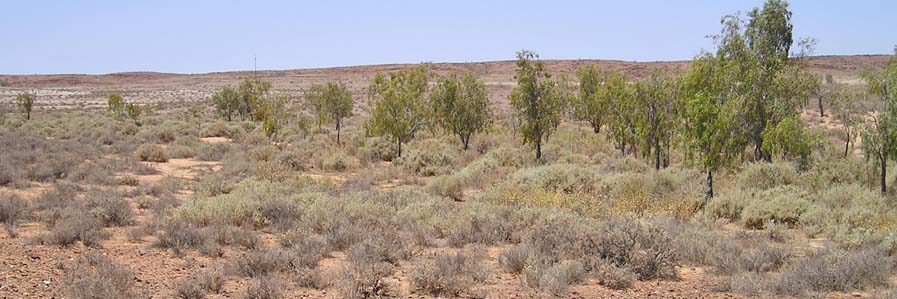 |
||
We found a pair rather quickly late one afternoon, but they remained amazingly invisible most of the time as they led us on a merry chase up and down through this habitat. Later, while checking out a known Rufous Fieldwren site, we found another that was remarkably tame. It even ran towards us to hide under a little bush (below, both shots). I would have much better photos when it posed briefly in the open had I not bungled the camera settings. Nonetheless, the heavy thick bill and prominently streaked crown and cheeks is apparent even in these overexposed shots. Portion of painting (right) by Richard Weatherly from Schodde (1982) |
||
|
#4 EYREAN GRASSWREN Amytornis goyderi |
 |
We visited one dune (above) twice, and watched pairs both times. One time a bird disappeared below a bush, despite being 'surrounded' by us. On closer inspection we found little bird tracks disappearing into the mouth of a burrow. On another sand dune, I stalked a bird and got very close, but it was only in the open, running fast, for short periods and I just couldn't snap a photo. My lone shot of one in a bush shows only its belly and legs. Yet this was my favorite grasswren. I liked its colorful pattern and heavy bill, and really enjoyed the way they ran up and down the dunes — this wonderful grasswren epitomizes this remote and spectacular desert country. Portion of painting (right) by Richard Weatherly from Schodde (1982) |
#5 GRAY (Grey) GRASSWREN Amytornis barbatus |
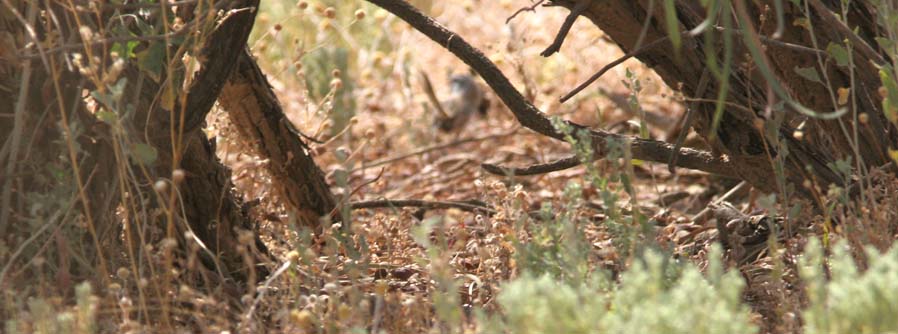 |
On our second visit to a site well up the Birdsville Track, I spent a lot of time stalking a bird that proved to be a fledgling Gray Grasswren (below). Schodde (1982) describes fledglings as "like adults but still duller and much fluffier, and having only the barest traces of dark chevrons on their faces. Brows are clear white but there is only a faint black line through the eye." The photographed bird had a much less prominent facial pattern than adults that were seen. Portion of painting (right) by Richard Weatherly from Schodde (1982) |
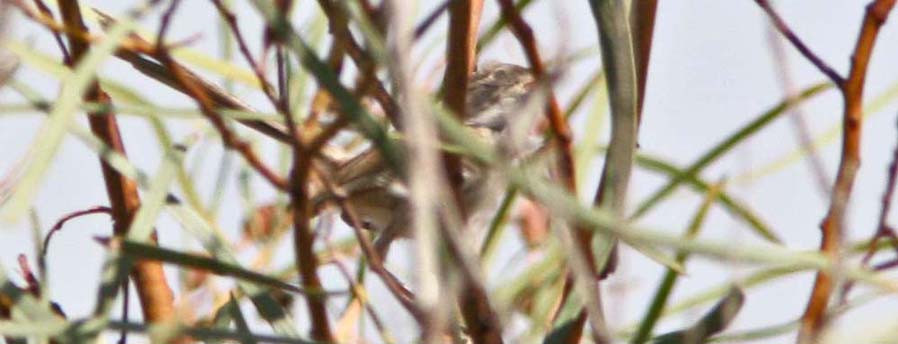 |
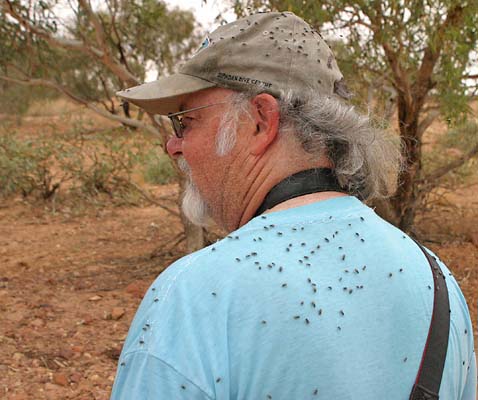 It
was very satisfying to observe the five species of grasswrens
encountered on this trip. Alas, with a 2800 km route and many other
birds to chase as well, the time spent with each grasswren was
necessarily short, and often in hot and uncomfortable conditions. At
each spot, flies were constantly trying to get moisture from eyes or
lips (see right, flies on my hat & shirt). Thus photographic
opportunities were very limited and I didn't really get a decent photo
of any species. What I've posted here are very poor shots of very
fidgety and elusive birds. I am jealous of some of the excellent
photos, now posted on the web, by others. But at least I've now seen
half of the world's grasswrens . . .
It
was very satisfying to observe the five species of grasswrens
encountered on this trip. Alas, with a 2800 km route and many other
birds to chase as well, the time spent with each grasswren was
necessarily short, and often in hot and uncomfortable conditions. At
each spot, flies were constantly trying to get moisture from eyes or
lips (see right, flies on my hat & shirt). Thus photographic
opportunities were very limited and I didn't really get a decent photo
of any species. What I've posted here are very poor shots of very
fidgety and elusive birds. I am jealous of some of the excellent
photos, now posted on the web, by others. But at least I've now seen
half of the world's grasswrens . . .
Literature cited:
- Schodde, R. 1982. The Fairy-Wrens: a Monograph of the Maluridae. Lansdowne Editions, Melbourne.
- Schodde, R., and I.J. Mason. 1999. Directory of Australian Birds: Passerines. CSIRO Publishing, Canberra.
South Australia MALLEE, FLINDERS & COASTAL HIGHLIGHTS |
|
South Australia BIRDSVILLE TRACK HIGHLIGHTS |
|
page created 28 Nov 2009
|
© Don Roberson 2009 |

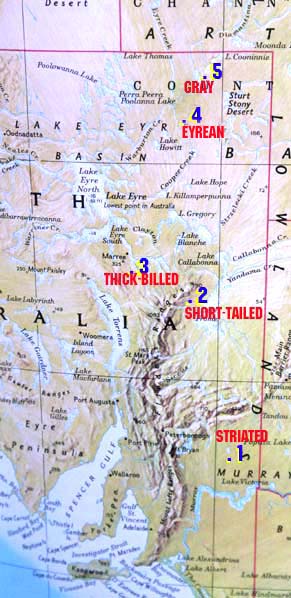
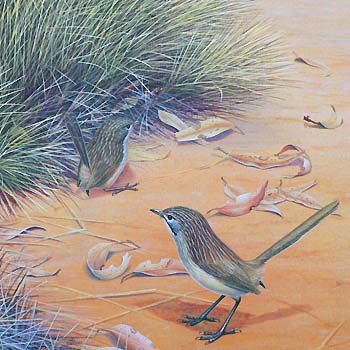 Striated Grasswren, of the nominate race A. s. striatus,
inhabits the Murray River mallee country. We searched for it in Gluepot
Reserve (above) where it lives among clumps of spinifex in the mallee
understory. It was extremely secretive, as are all the grasswrens. I
did not manage even one photo. Indeed, it took hours to find even one.
Peter had 9 locations on his GPS for Gluepot. We heard it once at the
first location but did not catch a glimpse. We tried a second site,
then back to the first, then on to the third. Still nothing. It was now
mid-day by the time we reached a 4th location, and the temperature was
up to 45°C [113°F]. It was stifling hot, and we were going
through gallons of water. Among the tour participants, only I 'needed'
this particular grasswren, so the pressure was on. At our 4th site we
split up, using walkie-talkies to keep in contact. It was, of course,
the other group that found one, and Peter & I hustled over to the
spot where they thought they had it surrounded. Fortunately, one dashed
from a clump and we were able to follow it. For a brief moment it
perched at the base of a clump, and I had nice views of the rusty
upperparts and distinctive malar stripe — and then it was off on the
run again, disappearing into the spinifex.
Striated Grasswren, of the nominate race A. s. striatus,
inhabits the Murray River mallee country. We searched for it in Gluepot
Reserve (above) where it lives among clumps of spinifex in the mallee
understory. It was extremely secretive, as are all the grasswrens. I
did not manage even one photo. Indeed, it took hours to find even one.
Peter had 9 locations on his GPS for Gluepot. We heard it once at the
first location but did not catch a glimpse. We tried a second site,
then back to the first, then on to the third. Still nothing. It was now
mid-day by the time we reached a 4th location, and the temperature was
up to 45°C [113°F]. It was stifling hot, and we were going
through gallons of water. Among the tour participants, only I 'needed'
this particular grasswren, so the pressure was on. At our 4th site we
split up, using walkie-talkies to keep in contact. It was, of course,
the other group that found one, and Peter & I hustled over to the
spot where they thought they had it surrounded. Fortunately, one dashed
from a clump and we were able to follow it. For a brief moment it
perched at the base of a clump, and I had nice views of the rusty
upperparts and distinctive malar stripe — and then it was off on the
run again, disappearing into the spinifex. 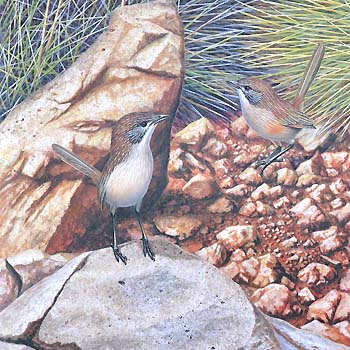 Short-tailed Grasswren
is a recent split from Striated (Schodde & Mason 1999). It inhabits
open spinfex-covered hills in the Flinders Range of South Australia.
One such site is Stokes Hill (above; L to R: Bruce Wedderburn, Peter
Waanders, Murray Lord). We arrived reasonably early in the morning, and
a pair were seen at a distance foraging between clumps of spinifex (the
short spiky clumps that cover this hillside). They disappeared as we
approached. By standing still and playing the tape, we finally finally
saw one grasswren running a bit closer (photo below), tail cocked high
above its bright reddish back. We approached closer, and suddenly a
bird darted from a close spinifex, moving much too fast to capture in
the lens. When we moved closer still, it dashed out again, zig-zagged
between us, and ran down a rabbit burrow! We waited but it never
re-emerged. Seeking refuge in burrows "when pressed closely" is
previously described for Striated and Thick-billed Grasswrens (Schodde
1982), but perhaps not for Short-tailed? However, given what we later
encountered with Eyrean, perhaps it is a behavior present in all
species?
Short-tailed Grasswren
is a recent split from Striated (Schodde & Mason 1999). It inhabits
open spinfex-covered hills in the Flinders Range of South Australia.
One such site is Stokes Hill (above; L to R: Bruce Wedderburn, Peter
Waanders, Murray Lord). We arrived reasonably early in the morning, and
a pair were seen at a distance foraging between clumps of spinifex (the
short spiky clumps that cover this hillside). They disappeared as we
approached. By standing still and playing the tape, we finally finally
saw one grasswren running a bit closer (photo below), tail cocked high
above its bright reddish back. We approached closer, and suddenly a
bird darted from a close spinifex, moving much too fast to capture in
the lens. When we moved closer still, it dashed out again, zig-zagged
between us, and ran down a rabbit burrow! We waited but it never
re-emerged. Seeking refuge in burrows "when pressed closely" is
previously described for Striated and Thick-billed Grasswrens (Schodde
1982), but perhaps not for Short-tailed? However, given what we later
encountered with Eyrean, perhaps it is a behavior present in all
species? 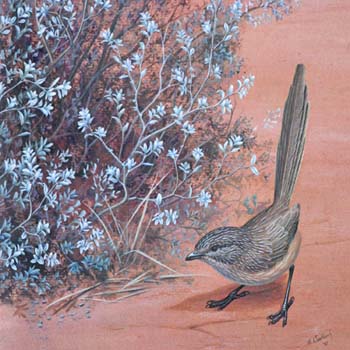 Thick-billed Grasswren, of the short-tailed eastern race modestus, was found at this well-known gully with saltbush (Atriplex)
understory near Lyndhurst (photo above). This species is widespread
across the interior of Australia (and locally to the western coast) in
shallow ravines with saltbrush or bluebush (Maireana) among
arid, open stony plains. The distribution of the two subspecies is odd,
however, and some suggest that they may actually represent two species.
Thick-billed Grasswren, of the short-tailed eastern race modestus, was found at this well-known gully with saltbush (Atriplex)
understory near Lyndhurst (photo above). This species is widespread
across the interior of Australia (and locally to the western coast) in
shallow ravines with saltbrush or bluebush (Maireana) among
arid, open stony plains. The distribution of the two subspecies is odd,
however, and some suggest that they may actually represent two species.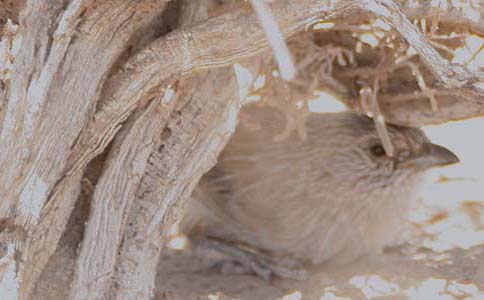

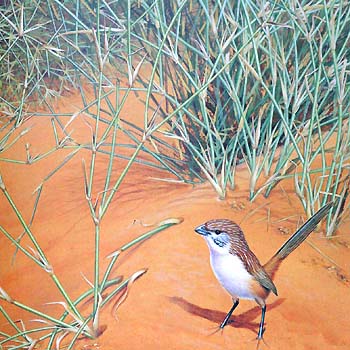 Eyrean Grasswren
was for many years considered a lost, and possibly extinct, species. It
was discovered in 1875 but nothing more was known for nearly a century.
Observers from Victoria believed they saw some in 1961 in an unexpected
habitat: dune cane grass on low sandhills, but a specimen was not
collected to confirm the rediscovery under 1976 (Schodde 1982). Since
then, though, as the great Simpson Desert has opened to travelers,
Eyrean Grasswren has proved to be reasonably common on sand dunes with
sufficient low vegetation (as shown in the photo above) throughout the
gibber deserts.
Eyrean Grasswren
was for many years considered a lost, and possibly extinct, species. It
was discovered in 1875 but nothing more was known for nearly a century.
Observers from Victoria believed they saw some in 1961 in an unexpected
habitat: dune cane grass on low sandhills, but a specimen was not
collected to confirm the rediscovery under 1976 (Schodde 1982). Since
then, though, as the great Simpson Desert has opened to travelers,
Eyrean Grasswren has proved to be reasonably common on sand dunes with
sufficient low vegetation (as shown in the photo above) throughout the
gibber deserts.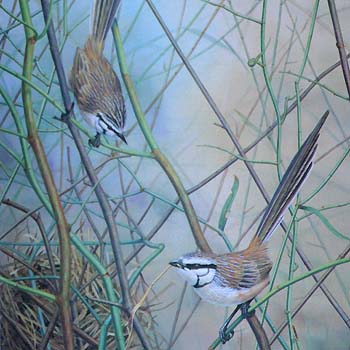 Gray Grasswren,
spelled "Grey Grasswren" in Britain and Australia, was the final
grasswren to be discovered to science. It is also the oldest and most
primitive of the grasswrens; it flies more often than other grasswrens;
and is more like a fairywren in structure. The species exists only in a
couple of usually dry flood plains that hold dense stands of lignum (Muehlenbeckia cunninghamii) and cane grass (Eragrostis australasica)
of the inland flowing Diamantina and Bulloo rivers (Schodde 1982). Our
birds were frustratingly elusive. Although males were seen briefly from
the car in track-edge lignum, it was very hard to locate pairs or
family groups among the dangled lignum and grass — usually the views
were of birds in flight or quickly running away (photo above; a
grasswren is running away, tail cocked, top center.
Gray Grasswren,
spelled "Grey Grasswren" in Britain and Australia, was the final
grasswren to be discovered to science. It is also the oldest and most
primitive of the grasswrens; it flies more often than other grasswrens;
and is more like a fairywren in structure. The species exists only in a
couple of usually dry flood plains that hold dense stands of lignum (Muehlenbeckia cunninghamii) and cane grass (Eragrostis australasica)
of the inland flowing Diamantina and Bulloo rivers (Schodde 1982). Our
birds were frustratingly elusive. Although males were seen briefly from
the car in track-edge lignum, it was very hard to locate pairs or
family groups among the dangled lignum and grass — usually the views
were of birds in flight or quickly running away (photo above; a
grasswren is running away, tail cocked, top center.